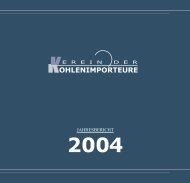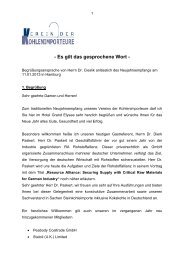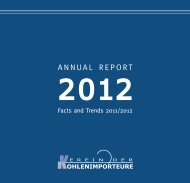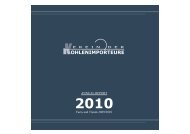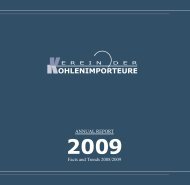Annual Report 2010 - Verein der Kohlenimporteure eV
Annual Report 2010 - Verein der Kohlenimporteure eV
Annual Report 2010 - Verein der Kohlenimporteure eV
You also want an ePaper? Increase the reach of your titles
YUMPU automatically turns print PDFs into web optimized ePapers that Google loves.
2. The Council still consi<strong>der</strong>s that a safe, secure, reliable,<br />
available, sustainable and adaptable energy<br />
supply contributes to European competitiveness and<br />
is a priority for Europe. Action at the EU level can<br />
and must bring added value to that objective.<br />
3. The EU needs a fully functioning, interconnected and<br />
integrated internal energy market. Council wants<br />
the internal market to be completed by 2014 so as to<br />
allow gas and electricity to flow freely. Transmission<br />
system operators together with the Agency for the<br />
Cooperation of Energy Regulators (ACER) should<br />
step up their work on market integration and<br />
guidelines, as well as uniform network codes.<br />
4. energy infrastructure is also a<br />
priority, especially to complete the internal market<br />
with cross-bor<strong>der</strong> connections and the integrated<br />
development of renewable energy sources. The bulk<br />
of the significant capital costs for infrastructure<br />
investment will have to be delivered by the market<br />
(i.e. network operators) with costs recovered through<br />
tariffs and thus paid by the consumer.<br />
5. The Council also consi<strong>der</strong>s security of energy<br />
supply as important and points the Commission –<br />
in the opinion of the coal sector, positively – to the<br />
following, priorities: “In or<strong>der</strong> to further enhance<br />
its security of supply, Europe’s potential for<br />
sustainable extraction and use of conventional<br />
and unconventional (shale gas and oil shale)<br />
fossil fuel resources should be assessed.” By<br />
June 2011, the Commission should also put<br />
forward a Communication on security of supply<br />
and international co-operation aiming to improve<br />
the consistency and coherence of the EU’s foreign<br />
policy in the field of energy.<br />
6. The European Commission is invited to strengthen<br />
its work with Member States on the implementation<br />
of the Renewable Energy Directive, in particular in<br />
regard to consistent national subsidies schemes and<br />
co-operation mechanisms.<br />
<br />
in renewable sources of energy as well as in safe<br />
and sustainable long-term low-CO 2 technologies<br />
(e.g. CCS). The Commission is invited to table<br />
new initiatives on smart grids, e-mobility, energy<br />
storage, sustainable biofuels and energy-saving<br />
solutions for cities.<br />
8. The European Council looks forward to the<br />
elaboration of a low-carbon 2050 strategy providing<br />
the framework for longer-term actions in the energy<br />
sector and other related sectors. Reaching the EU<br />
objective of reducing greenhouse gas emissions<br />
by 80-95% by 2050 compared with 1990, as<br />
agreed in October 2009 and as the IPPC consi<strong>der</strong>s<br />
necessary by developed countries as a group, will<br />
require a revolution in energy systems, which must<br />
start now. Due consi<strong>der</strong>ation should be given to<br />
<br />
2050 objective. The European Council will keep<br />
developments un<strong>der</strong> review on a regular basis.<br />
With these conclusions, the Council essentially<br />
confirmed the European Commission’s strategy and<br />
at the same time gave a new mission to the European<br />
Commission: to draft an energy policy for the next forty<br />
years, clearly centred on reductions of CO 2 emissions<br />
and other greenhouse gases. The European Commission<br />
subsequently announced three so-called “road maps” to<br />
be launched in 2011 and establishing guidelines on how<br />
CO 2 emissions might be lowered by 80-95% by 2050,<br />
covering the economy as a whole and including both<br />
transport and energy.<br />
35



